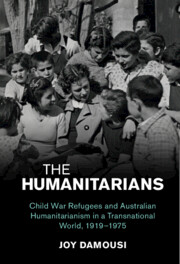 The Humanitarians
The Humanitarians Conclusion
Published online by Cambridge University Press: 28 July 2022
Summary
Over the twentieth century, organisations and individuals have mobilised to offer what they understood as humanitarian assistance to war child refugees. Some were so motivated and desperate to save children from the violence of war that surrounded them that they abducted, smuggled and physically removed children to what they believed was a safe haven from conflict – faraway Australia. This work is bookended by two such cases – on the battlefields of the Great War and the civil conflict of the Vietnam War. While in 1919 this action may have been seen as noble, even heroic, towards the latter part of the century, in 1972, what had by then morphed into the issue of inter-country adoption, was a hotly debated and intensely contested practice which was opposed and resisted by many international humanitarian groups. This act by then was seen as anything but ‘humanitarian’. Along the way, debates raged about whether evacuation and separation from parents in global war created the problem or the solution for children displaced by war. How best to protect children in times of conflict and beyond it preoccupied humanitarians. In order to capture the complexity and multilayered meaning of humanitarianism, I have historicised the notion of it by moving beyond it as an assumed or given category and framed this study in the context of the history of one nation – Australia – and one focus – child war refugees across several twentieth-century wars and conflicts.
- Type
- Chapter
- Information
- The HumanitariansChild War Refugees and Australian Humanitarianism in a Transnational World, 1919–1975, pp. 317 - 324Publisher: Cambridge University PressPrint publication year: 2022
